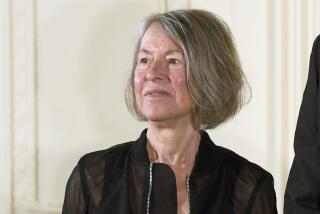Audrey Geisel, Dr. Seuss’ widow and noted philanthropist, dies
- Share via
Before popular children’s author Theodor “Dr. Seuss” Geisel died in 1991, he told his wife, Audrey, that she would be “the one who would have to live with all the critters and move them on.”
That she did, shepherding his legendary menagerie – the Cat in the Hat, the Grinch, Horton, the Lorax – into the 21st Century, where it continues to entertain new generations of youngsters.
Mrs. Geisel died Wednesday at her Mount Soledad home. She was 97.
Small physically, she was a big protector of her husband’s creations and legacy, and a major donor to institutions he supported and helped to flourish, including UC San Diego and the zoo.
“Those things were important to her because she knew they would have been important to him,” said Jeanne Jones, a longtime family friend.
Born Audrey Stone on Aug. 14, 1921 in Chicago, she grew up in a household jostled by hard times, according to an obituary prepared by the family. Her father was a “song and dance man,” and soon disappeared from her life. She lived with her mother, or family friends, or, once, in foster care.
At age 21, she went to Indiana University to study nursing and met E. Grey Dimond, a pre-med student who would become her husband. They both worked at Massachusetts General Hospital in Boston before moving to Kansas, where he was the dean of cardiology at the University of Kansas. They had two daughters there.
In 1960, they moved west to La Jolla, where the Dimonds traveled in the same social circles as longtime La Jollans Ted Geisel and his wife, Helen Palmer, also a writer and an important early influence on his work.
According to the authorized 1995 biography “Dr. Seuss & Mr. Geisel,” Ted and Audrey began having an affair, and after his wife died by suicide in October 1967, she obtained a divorce. They were married in 1968.
By then Dr. Seuss was a household name, widely applauded for sparking a love of reading in kids previously bored by the “Dick and Jane” primers given to them in schools.
Mrs. Geisel is sometimes credited with helping to expand the color palette in his drawings and nudging his stories in the direction of social issues through books such as “The Lorax,” which has environmental themes, and the “The Butter Battle Book,” an anti-war story.
When they weren’t immersed in his work, they enjoyed entertaining friends on Mount Soledad. If the energy at a dinner party started fading, he would grab hats from a closet and put them on the heads of the guests.
“Believe me,” Mrs. Geisel said in a 1999 interview, “when you get a dozen people seated at a fairly formal dinner party and they’ve all got on perfectly ridiculous chapeaus, the evening takes care of itself.”
Jones, the longtime family friend, said the Geisels “were funny together. They teased each other a lot.” Their 1984 Cadillac, which Mrs. Geisel kept even after she was no longer able to drive, had a personalized license plate: GRINCH.
After his death in September 1991 at age 87, the city held a tribute in Balboa Park, where Mrs. Geisel talked about his legacy in a way that foreshadowed her subsequent efforts to protect and promote his work.
“His name never comes up when you’re talking about the underbelly of the world,” she told the Union-Tribune. “It is always used when you’re talking about the good, the best of the world.”
A year later, she donated more than 4,000 items — original sketches and manuscripts, college notebooks, letters — to the library at UC San Diego, expanding his reach from popular culture into the world of academic research.
“She wanted to make sure the items were preserved physically, and preserved in a way that would allow people to come in and understand how he did his work,” said Lynda Claassen, director of Mandeville Special Collections at the library.
More donations over the years have created a repository of more than 20,000 items. They are housed in the Geisel Library, so named after Mrs. Geisel donated $20 million to it in 1995.
Counterfeiters who thought Seuss’ death allowed them to put his iconic images on T-shirts or posters soon found that they were mistaken. Mrs. Geisel’s attorneys aggressively went after them for copyright infringement. One 1993 suit brought a $750,000 judgment against an Oxnard wholesaler.
When anti-abortion groups started using a “Horton Hears a Who!” line — “A person’s a person, no matter how small” — she protested that, too.
“Ted never allowed his work to be used for political purposes,” she told the Union-Tribune in 2008.
The ongoing popularity of Seuss — his four-dozen books have sold more than 650 million copies worldwide — also created steady interest in film and theater adaptations and related merchandise. Seuss Enterprises, with Mrs. Geisel as president, was set up to license the use of the characters.
Not all of the projects have been well-received critically, but they have been lucrative. Forbes estimated his estate’s earnings over the past year at $16 million, placing him sixth on the magazine’s list of highest-paid dead celebrities, just behind Bob Marley and ahead of Hugh Hefner.
As new commercial proposals came in, Mrs. Geisel was involved in the decision-making. During the production of an animated “Horton” movie ten years ago, for example, she insisted certain things be changed. Horton’s teeth were too big, she believed. The kangaroo’s pouch hung too low.
Unhappy with the live-action version of “The Cat in the Hat” starring Mike Myers — several critics named it the worst movie of 2003 — she decreed that all future Seuss-based films would be animated.
She also had a hand in discovering “lost” Seuss manuscripts as she went through the mountain of material he left behind in desk drawers and closets. That led to the 2015 publication of “What Pet Should I Get?” which was probably written some time between 1958 and 1962.
“I totally, wonderfully approve of anything that comes to light at this time of Ted’s work,” Mrs. Geisel said in a 2011 interview.
Survivors include her daughters, Leagrey Dimond and Lark Grey Dimond-Cates. In an obituary Dimond wrote, she remembered her mom as an “extraordinary whistler” who never complained, loved parades, “dancing cheek to cheek,” and holidays.
“Mom was petite, beautiful, strong-willed, charming and fun,” the obituary said. “She never looked back — only forward — and she had a great spirit for life. She sailed forth with that distinctive walk: head up, shoulders back, jaunty, as if she had just twirled her baton.”
Services are pending.
john.wilkens@sduniontribune.com
UPDATES:
12:20 p.m.: This article was updated with additional information.
This article was originally published at 7:20 a.m.
More to Read
Start your day right
Sign up for Essential California for the L.A. Times biggest news, features and recommendations in your inbox six days a week.
You may occasionally receive promotional content from the Los Angeles Times.







